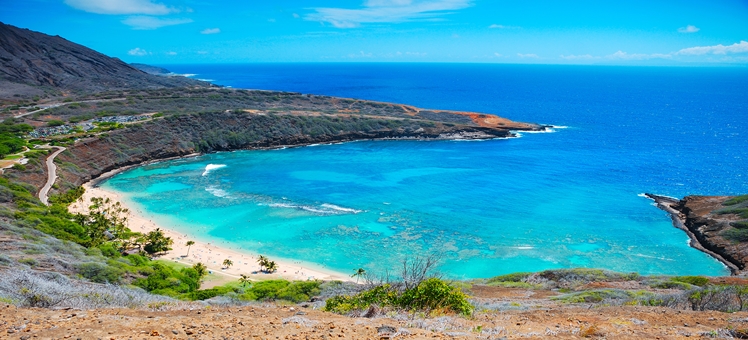
As the largest of the islands in Hawaii’s archipelago, ‘Big Island’- also known simply as ‘Hawaii Island’ - has a vast canvas of attractions to explore. Home to not only the largest sub aerial volcano on Earth, Mauna Loa, but also one of the most active, Kilauea, the island is truly a geologist’s dream. The island is also home to the world’s largest mountain, when measured from its oceanic base, Mauna Kea. With a whole host of other first class attractions, including beautiful snow capped mountains, stunning black-sand beaches and lush rainforests, ‘Big Island’ is the perfect holiday destination.
HiloAs the island’s capital and county seat, Hilo (divided into two districts, ‘north’ and ‘south’) is the obvious starting point on any trip to ‘Big Island’. This is the place to come if you’re looking to immerse yourself in city culture, as with over 40,000 residents, Hilo is by far the most populated settlement on the island. Framed by the imposing peaks of Mauna Loa and Mauna Kea, and the stunning Hilo Bay, it’s certainly picturesque. Charming banyan trees line the roads, friendly locals go about their day to day business, and a rich culture can be felt throughout the entirety of the town, particularly in its epicentre Kalakaua Park – making it a must on any trip to the island. Major attractions here include the beautiful Rainbow waterfalls, Lili’oukalani Park and Gardens, the Pana’ewa Rainforest Zoo and the Pacific Tsunami Museum.Hamakua
A district located in the north of the island, Hamakua is renowned for its stunning section of coastline. Known simply as the ‘Hamakua Coast’, this 50 mile stretch is a major attraction for those looking for wild water and even wilder scenery. What’s interesting here is how different this section of coast is when compared to other locations on the island. According to the Hui Malama i ke Ala Ulili people, ‘Hamakua’ is known for its “steep mountain trails”, and it’s easy to see why. There are no sandy stretches of beach here: instead, steep erosional cliffs and valleys, as well as the magnificent Mauna Kea, dominate. Amazingly, at 33, 100 feet (10,100 metres), Mauna Kea’s base to peak height is twice that of Mount Everest!
Ka’u
Ka’u is the southernmost district on ‘Big Island’. Its signature attraction lies in the Hawai’i Volcanoes National Park, most of which falls inside the district. Designated as an International biosphere Reserve in 1980 and a World Heritage Site in 1987, it really is a must on any trip here. With a range of unique hiking and camping opportunities, this is the perfect place for those looking to stretch their legs and take in the view. The reserve is not easy to miss either, particularly with Mauna Lao and Kilauea looming somewhat ominously. What’s more, as Kilauea is one of the world’s most active volcanoes, you’re more than likely to see some flowing larva.
Kohala
Right in the northern tip of ‘Big Island’, Kohala (like Hilo divided into ‘north’ and ‘south’) is the place to come if you’re looking for wide expanses of beach, plunging cliffs, and excellent golf courses and resorts. Dominated by the island’s oldest volcano, the one million year old Kohala Mountain, this district is ideal for those looking for exquisite scenery and an active holiday.
Kona
Located to the Island’s west, on its ‘Leeward’ side (Kona literally means ‘Leeward’ or ‘dry’ in Hawaiian), Kona (again divided into ‘north’ and ‘south’ districts) offers some of the best weather on the island. Kona is also home to the world-famous Ironman World Championship – perfect for those fitness enthusiasts looking for that next challenge! Other attractions here include the Kealakekua Bay Historical District, where scuba diving and kayaking are popular, as well as the Honokohau Settlement and Kaloko-Honokohau National Historical Park – a U.S. ordered park designated for the preservation, protection, and interpretation of traditional native Hawaiian activities and culture.
Puna
With a size of just under 320,000 acres, Puna, located on ‘Big Island’s’ easternmost point, is just slightly smaller than the Hawaiian island of Kaua’i. Like its district neighbor Ka’u, Puna’s main draw is the Hawai’i Volcanoes National Park. Puna’s natural environment is predominantly a result of volcanic activity, and eruptions of Kilauea and nearby Mauna Lao continue to shape the region. Puna is also known for its agricultural tourism, which includes the cultivation of coffee, sugar, macadamia nuts and papayas.